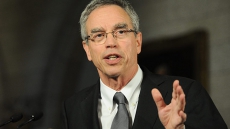Energy industry players say they've learned from last year's so-called polar vortex and are bracing for what the Farmer's Almanac says will be another bitterly cold season — one that's already being dubbed the "T-Rex" of winters.
But a number of factors, including unpredictable winter temperatures and the strength of the Canadian dollar, could create a perfect storm and trigger a spike in energy prices, much like the one that occurred last year.
As it prepares next month's annual prediction of what lies ahead for the 2014-15 heating season, the National Energy Board says it's basically a crap shoot.
"The forecasts for weather are just that — they are forecasts. They're going to be wrong and it just so happens that last year was an extreme case of being wrong," said Darren Christie, the NEB's director of energy markets.
Last winter — as if anyone could forget — saw near-record cold weather in some key energy markets in North America, and no one seemed to see it coming.
"The main forecast that we look at for weather just didn't predict it," Christie said.
The board's 2013-14 Winter Energy Outlook predicted lower natural gas and heating oil consumption, and slightly lower prices, based largely Environment Canada's prediction of milder-than-normal temperatures.
But a spike in demand for propane to dry crops in the United States and one of the longest and coldest winters in nearly four decades resulted in heating fuel shortages for farmers and rural residents, and higher overall energy prices.
Home heating oil and natural gas prices skyrocketed along with the cost of propane — so much so that industry observers were fearful of a price hangover for this winter. That didn't happen, though, largely because producers pumped out excess supply over the summer.
Midway through the last heating season, the federal government ordered a review by the National Energy Board and the Competition Bureau of of pricing and supply issues in the country's energy markets.
That review was completed in April but no government legislative actions were taken as a result.
For the upcoming season, some industry players have changed the way they prepare for the winter.
Enbridge — which typically stocks up on natural gas on the open market in the low season, hoping it has enough to cover its customers for the rest of the year — changed tactics earlier in 2014.
First, it made sure that all of its storage tanks were topped up as much as possible.
It also changed how it buys supply, doing it early in the season as customers draw down stored reserves, rather than waiting until supplies are diminished later in the season when the open market could be vulnerable to wide price fluctuations.
"We have looked at different ways of doing our gas purchasing, which will help to protect our customers from potential pricing spikes," said Jamie LeBlanc, Enbridge's director of energy supply and policy.
One underlying concern that's already on the horizon is the supply of natural gas in western Canada.
The shortfall has resulted in natural gas storage within a range that's lower than the five-year minimum average overall, although reserves in eastern Canada are at or above the five-year average.
First Energy Capital Corp. reported natural gas reserves in Canada of 559 billion cubic feet in August. Canada had reserves of 723 billion cubic feet during the same month last year while the five-year minimum average was at 632 bcf.

"We do know that there's a lower storage level in the West, which is a little concerning to us if we get another cold winter," said LeBlanc.
If there's a repeat of last year in the Toronto area, Enbridge said it has enough natural gas in storage to easily supply all of its customers.
But if the weather turns colder than expected in the West, that could put upward pressure on prices as supplies are used up, said LeBlanc.
The outlook in the U.S. is so far sending mixed signals.
The U.S. Energy Information Administration reported a 15 per cent drop in spot prices for natural gas in September despite fast-paced production and storage of the fuel that exceeded historic norms.
Natural gas spot prices averaged $3.91 US per million British thermal units in August, down from $4.59 in June.
At the same time, inventories were down by about 15 per cent by the end of August compared with the same time a year ago as well as the previous five-year average.
In Canada, lower spot prices have already resulted in some utilities passing on the savings to consumers, at least in the run up to winter.
For example, FortisBC sought approval from the B.C. Utilities Commission last month to decrease natural gas rates for most of its customers. That price drop took effect Oct. 1.
As well, propane inventories — which dropped to dangerously low levels at the peak of the last winter season — have rebounded.
The NEB reported 1.77 billion cubic metres of propane supply across Canada in September, up from 1.42 billion cubic metres during the same month in 2013.
Home heating energy consumption in Canada has dropped over the past 20 years largely as a result of conservation efforts and home retrofitting programs.
And LeBlanc says homeowners should continue to heed the advice of conservation advocates to save money, by reinsulating drafty windows and doors and turning down the thermostat at night.





